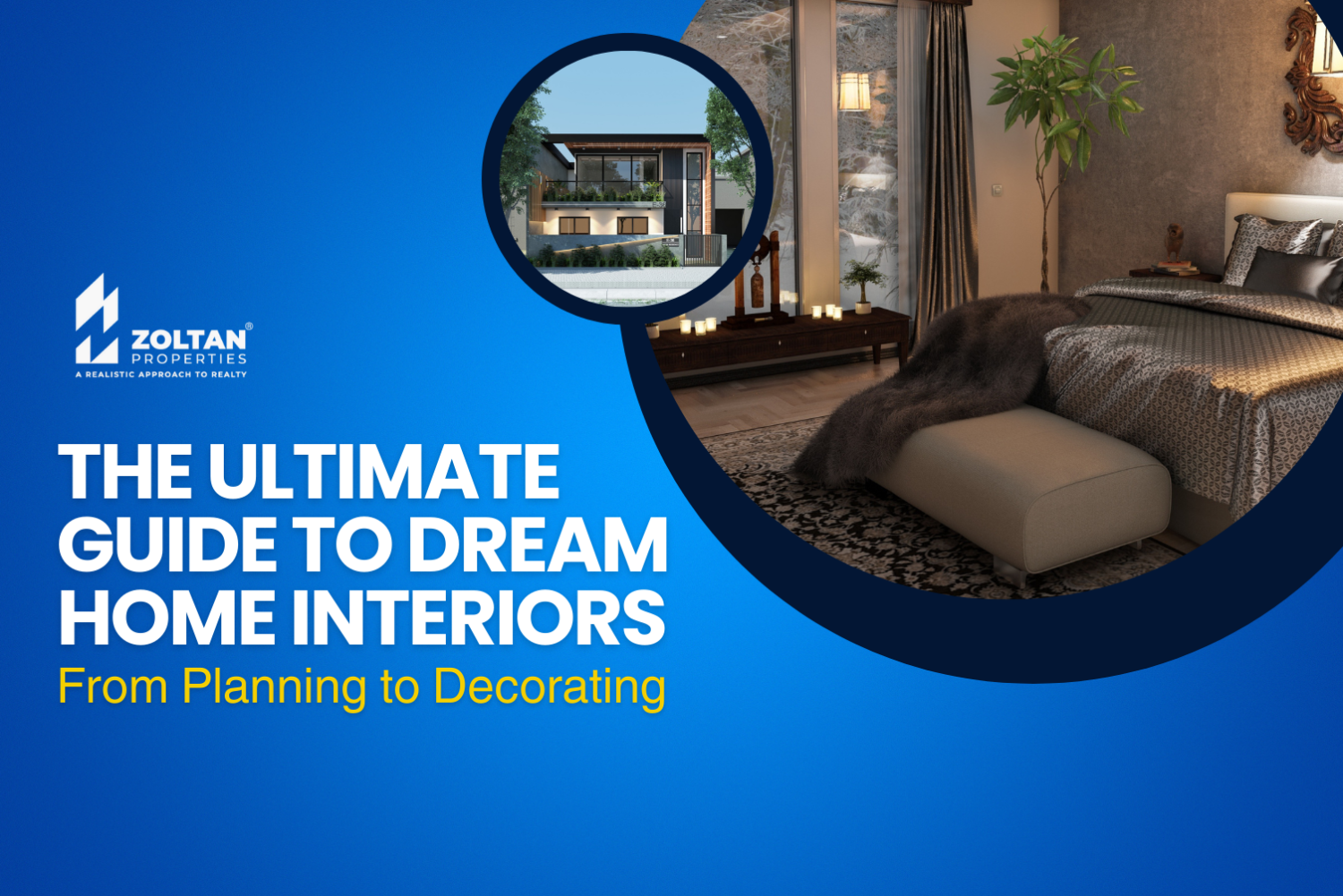Introduction
Designing and decorating your dream home is an exciting and fulfilling endeavor. The interior of your home reflects your personality and style while providing comfort and functionality. This comprehensive guide will take you through essential aspects of interior design, including layout, integrated technology, furnishing, and decor. By paying attention to these elements, you can create a space that is not only visually appealing but also perfectly tailored to your lifestyle.
Layout: Creating Functional Spaces
The layout of your home sets the foundation for a functional and well-designed interior. Consider the following tips:
Room Zoning
Room zoning is a way of dividing a large or open-plan space into different functional areas, such as living, dining, working, sleeping, etc. Room zoning can help you make the most of your space, create a comfortable and organized environment, and add some style and personality to your home. Here are some ways to do room zoning:
Use different flooring or rugs to visually separate different zones. For example, you can use tiles in the kitchen area and wood in the dining area, or you can lay rugs under the sofa, the dining table, and the bed to create cozy and defined spaces12
Use furniture or partitions to create physical barriers between zones. For example, you can use a sofa, a bookcase, a shelving unit, a screen, or a curtain to divide the living room from the bedroom or the office. Furniture and partitions can also provide extra storage and privacy12
Use color, lighting, and accessories to create different moods and atmospheres in each zone. For example, you can use warm colors, soft lighting, and cozy cushions in the sleeping area, and bright colors, natural light, and plants in the working area. Color, lighting, and accessories can also help you highlight your personal style and taste12
Use zoning controls to adjust the temperature and ventilation in each zone according to your needs. For example, if you have a central-ducted air conditioner, you can use zoned controls to cool only the parts of the home that you need to save energy and money. You can also close doors, windows, and curtains in rooms you are cooling to cool them more quickly
Space Optimization
Space optimization in interior design is the process of making the best use of the available space in a home or building, according to the functional requirements, aesthetic preferences, and budget constraints of the client. Space optimization can help you create a comfortable, efficient, and attractive environment that meets your needs and expectations. Here are some ways to do space optimization in interior design:
Use space planning to determine the purpose, layout, and furniture arrangement of each area in your home or building. Space planning can help you avoid wasting space, improve circulation and accessibility, and enhance the functionality and appearance of your space1
Use multifunctional and flexible furniture that can serve more than one purpose or adapt to different situations. For example, you can use a sofa bed that can turn into a sleeping area, a coffee table that can extend into a dining table, or a desk that can fold into a wall. Multifunctional and flexible furniture can help you save space, reduce clutter, and increase versatility2
Use vertical space to create more storage and display options. For example, you can use wall-mounted shelves, cabinets, hooks, or racks to store and organize your items. You can also use hanging plants, artworks, mirrors, or lighting fixtures to decorate and brighten up your space. Using vertical space can help you free up floor space, create visual interest, and make your space feel larger2
Use color, lighting, and accessories to create illusions of space and depth. For example, you can use light colors, mirrors, or transparent materials to reflect light and make your space feel more spacious. You can also use dark colors, contrast, or patterns to create focal points and define zones. Color, lighting, and accessories can help you enhance the mood and style of your space
Traffic Flow
Traffic flow in interior design is the way people move through a space, such as a home, office, or store. Traffic flow affects the functionality, comfort, and safety of a space, as well as the mood and style of the people who use it. Here are some ways to do traffic flow in interior design:
Use space planning to determine the main pathways and zones in your space. Space planning can help you avoid wasting space, improve circulation and accessibility, and enhance the functionality and appearance of your space1
Use furniture or partitions to create physical barriers or guides between zones. Furniture or partitions can also provide extra storage and privacy. For example, you can use a sofa, a bookcase, a shelving unit, a screen, or a curtain to divide the living room from the bedroom or the office23
Use color, lighting, and accessories to create visual cues or contrasts between zones. Color, lighting, and accessories can also help you enhance the mood and style of your space. For example, you can use warm colors, soft lighting, and cozy cushions in the sleeping area, and bright colors, natural light, and plants in the working area23
Use safety measures to prevent accidents or injuries in your space. Safety measures can include things like marking or avoiding obstacles or obstructions, using slip-resistant flooring or rugs, installing proper lighting and ventilation, and following industry regulations or personal preferences for access and emergency exits
Integrated Technology: Enhancing Convenience and Connectivity
Incorporating integrated technology into your home can elevate your living experience. Consider the following aspects:
Smart Home Automation
Smart home automation is the use of technology to control and manage various aspects of your home, such as lighting, heating, security, entertainment, and more. Smart home automation can make your home more comfortable, convenient, secure, and energy-efficient. Here are some tips for interior design with smart home automation:
Use a smart hub or a voice assistant to centralize and simplify the control of your smart devices. A smart hub or a voice assistant can allow you to use one app or one command to control multiple devices at once. For example, you can say “Good morning” to your voice assistant and have it turn on the lights, adjust the thermostat, play your favorite music, and brew your coffee1
Use smart lighting to create different moods and atmospheres in your home. Smart lighting can allow you to change the color, brightness, and temperature of your lights according to your preference or the time of day. You can also set schedules and scenes for your lights to turn on and off automatically or with a single tap. For example, you can create a cozy scene for your living room with warm and dim lights, or a productive scene for your home office with bright and cool lights23
Use Thermostats to optimize the temperature and comfort of your home. Thermostats can allow you to adjust the temperature of your home remotely or with a voice command. You can also set schedules and routines for your heating/cooling to turn on and off according to your daily activities or the weather. For example, you can have your heating/cooling turn on before you wake up or come home, and turn off when you leave or go to bed
Use smart security to protect your home and family. Smart security can include devices such as smart locks, cameras, doorbells, alarms, sensors, and more. Smart security can allow you to monitor and control your home security from anywhere with your phone or tablet. You can also receive alerts and notifications when something unusual happens or when someone visits your home. For example, you can use a smart lock to unlock your door with your phone or a code, or use a smart camera to see who is at your door or what is happening in your backyard
Audio-Visual Systems
Audio-visual systems are devices and technologies that enable the transmission and display of sound and images in a space, such as a home, office, or store. Audio-visual systems can enhance the functionality, comfort, and aesthetics of a space, as well as the communication and collaboration of the people who use it. Here are some tips for interior design with audio-visual systems:
Use a smart hub or a voice assistant to centralize and simplify the control of your audio-visual devices. A smart hub or a voice assistant can allow you to use one app or one command to control multiple devices at once. For example, you can say “Play Netflix” to your voice assistant and have it turn on your TV, soundbar, and streaming device1
Use wireless or hidden speakers to create a surround sound effect without cluttering your space. Wireless or hidden speakers can allow you to enjoy high-quality sound without compromising your interior design. You can place wireless speakers anywhere in your space, or use hidden speakers that are built into the walls, ceilings, or furniture23
Use a projector or a large screen to create an immersive and cinematic experience in your space. A projector or a large screen can allow you to watch movies, shows, games, or presentations on a big scale. You can also use a projector or a large screen to display artworks, photos, or videos as a form of decoration23
Use smart lighting to complement and enhance your audio-visual system. Smart lighting can allow you to change the color, brightness, and temperature of your lights according to your preference or the content you are watching or listening to. You can also set schedules and scenes for your lights to turn on and off automatically or with a single tap. For example, you can create a movie scene for your living room with dim and warm lights, or a party scene with colorful and flashing lights
Connectivity
Designate areas for charging stations and ensure sufficient electrical outlets to accommodate the increasing number of devices we use in our daily lives.
You can use a charging drawer in your kitchen or living room to store and charge your devices without cluttering your surfaces1. You can also use a tip-out drawer in front of a sink or range for smaller devices1.
You can use strong colors and lights to make your charging stations stand out and attract attention2. You can also use clear instructions, simple pricing information, and customer support information to make them user-friendly2.
You can use open shelves or nooks in a pass-through space to tuck away your devices while charging them1. This way, they are partially hidden from view but still accessible.
You can use a ground-fault protection device and a DC ground-fault monitor to ensure safety and avoid electrical shock when using high-power charging stations4. These devices will detect any earth leakage and shut off power immediately.
Furnishing: Balancing Comfort and Aesthetics
Choosing the right furniture is essential for both comfort and visual appeal. Keep the following in mind:
Ergonomics
Ergonomics is about creating furniture and spaces that are comfortable, safe and functional for the user’s body and well-being. Here are some tips based on the web search results:
Ergonomic furniture should not restrict but further enhance natural movement and flow of the human body, support natural S posture of the spine rather than forcing it into a C shape, be easily adjusted to accommodate a diverse range of people, encourage more physical movement during the day where possible, put usability ahead of aesthetic or convenience, and reduce stress of joints, bones and muscles1.
Ergonomic furniture layout should allow for comfortable and easy movement, make sure that pathways are clear and that furniture is positioned at the right height for the people who will be using it2. It should also take into account the individual needs of each person in terms of size, shape, mobility, and ability, as well as the physical demands of their job or lifestyle3.
Ergonomic furniture design should use materials that are durable, easy to clean and maintain, and avoid sharp edges or corners that could cause injury4. It should also use colors and textures that are soothing and harmonious, and avoid glare or excessive brightness that could strain the eyes5.
Size and Scale
Size and scale are important aspects of interior design that affect the balance and harmony of a space. Here are some tips based on the web search results:
Use the golden ratio of 1:1.618 to create pleasing proportions for objects and their aesthetics. You can also use the rule of thirds to divide a space into three equal parts and place the focal point at one of the intersections.
Create contrast by using different sizes and shapes of furniture and decor items to add interest and dynamism to a space. You can also use patterns that are scaled according to the room size, such as smaller patterns for smaller rooms and larger patterns for larger rooms.
Use white space efficiently by leaving some surfaces uncovered and some walls alone to give the eye room to rest in a space.
Don’t stick to the layout by experimenting with different furniture arrangements and angles to create a more dynamic and flexible space. You can also use architectural detailing such as moldings, columns, or beams to create visual interest and define different zones in a space.
Use a floor plan and furniture layout to plan your space before buying or moving any furniture or decor items. You can use graph paper or online tools to measure your room and draw the boundaries, installations, furniture pieces, and traffic flow. You can also use cutouts or sticky notes to represent different furniture pieces and move them around until you find the best layout.
Quality and Durability
Quality and durability are essential factors to consider when choosing furnishing for interior design. Invest in furniture made from high-quality materials that can withstand daily use and stand the test of time. This ensures longevity and minimizes the need for frequent replacements. Here are some tips based on the web search results:
Choose materials and finishes that are durable, easy to clean and maintain, and suitable for the intended use of the furniture. For example, granite is a durable and easy to clean material that is often used for countertops, while wood is a versatile and affordable material that can be used for floors, ceilings, and walls.
Look for furniture that has solid construction, quality craftsmanship, and good warranty. You can also check for certifications or reviews that indicate the quality and durability of the furniture.
Use synthetic materials such as vinyl and laminate when the budget is a concern or when you want to achieve a specific look or style. These materials can mimic the appearance of natural materials such as wood or stone, but they are usually cheaper and more resistant to wear and tear.
Use copper as an accent material to add some elegance and warmth to your space. Copper is a durable and corrosion-resistant material that can be used for hardware, lighting fixtures, or decorative items.
Use tile as a versatile and durable material that can be used for floors, walls, backsplashes, or countertops. Tile comes in various colors, shapes, sizes, and patterns that can suit any style or preference.
Decor: Adding Personality and Style
Decorative elements bring life and personality to your home. Consider the following tips:
Color Palette
Choose a color scheme that reflects your taste and creates a cohesive look throughout your home. Experiment with different shades and tones to create the desired ambiance.
Color palette is one of the most important aspects of interior design, as it can create different moods, atmospheres, and styles for a space. Here are some tips based on the web search results:
Use the color wheel to understand the basic principles of color harmony and contrast. You can use complementary colors (opposite on the wheel) to create a vibrant and dynamic look, analogous colors (adjacent on the wheel) to create a harmonious and soothing look, or monochromatic colors (different shades of the same color) to create a sophisticated and elegant look.
Use the 60-30-10 rule to balance your color palette and create visual interest. This rule suggests that you use 60% of a dominant color, 30% of a secondary color, and 10% of an accent color in your space. The dominant color should be a neutral or a light color that sets the tone for the room, the secondary color should be a contrasting or complementary color that adds some character to the room, and the accent color should be a bright or bold color that adds some flair to the room.
Use color psychology to choose colors that match the function and mood of the room. For example, red is associated with passion, energy, and action, so it can be used for dining rooms or living rooms where you want to stimulate appetite or conversation. Blue is associated with tranquility, calm, and intelligence, so it can be used for bedrooms or home offices where you want to promote relaxation or concentration. Yellow is associated with happiness, optimism, and energy, so it can be used for kitchens or home offices where you want to boost creativity or productivity.
Use pastel colors to create a soft, cozy, and relaxed look for your space. Pastel colors are light and muted colors that have a soothing effect on the eyes and the mind. They can also make your space look more spacious and airy. Some of the pastel colors that are trending this season are whimsy yellow, light azure, millennial pink, and creamy white.
Use cool colors to create a sleek, modern, and sophisticated look for your space. Cool colors are colors that have blue undertones and evoke a sense of freshness and elegance. They can also make your space look more clean and crisp. Some of the cool colors that are popular this season are navy blue, burgundy, gray, and red.
Texture and Patterns
Texture and patterns are elements of interior design that can add depth, dimension, and personality to a space. Incorporate various textures and patterns through textiles, wallpapers, and accessories. This adds visual interest and depth to your interiors. Here are some tips based on the web search results:
Use geometric patterns to create a modern and dynamic look for your space. You can use geometric patterns on walls, floors, furniture, or accessories to create visual interest and contrast. You can also mix different geometric shapes and colors to create a unique and playful look.
Use natural textures to create a warm and cozy look for your space. You can use natural textures such as wood, stone, or greenery to add warmth and a sense of calm to your space. You can also use natural textures on paneling, walls, or plants to create a connection with nature.
Use bold graphics to create a pop of color and personality for your space. You can use bold graphics such as large-scale murals, typography, or artwork to add some flair and character to your space. You can also use bold graphics to express your style, message, or theme.
Use pastel colors to create a soft and relaxed look for your space. You can use pastel colors such as light yellow, azure, pink, or white to create a soothing effect on the eyes and the mind. You can also use pastel colors to make your space look more spacious and airy.
Use texture to create contrast and balance for your space. You can use texture to add some variety and interest to your space. You can also use texture to balance out smooth or shiny surfaces with rough or matte ones. You can use texture on rugs, pillows, throws, or tapestries to add some coziness and comfort.
Personal Touches
Personal touches are what make a space feel like home. They reflect your style, personality, and preferences. Display artwork, photographs, and mementos that hold sentimental value to create a personalized and inviting atmosphere. Here are some tips based on the web search results:
Use family photos to create a personal and sentimental gallery wall. You can use different frames, sizes, and layouts to create a unique and eye-catching display. You can also use family heirlooms, such as vintage furniture, jewelry, or art, to add some history and character to your space.
Use meaningful art to express your taste, interests, and passions. You can use art that you created yourself, bought from a local artist, or collected from your travels. You can also use art that has a personal message, such as a quote, a poem, or a song lyric.
Use travel mementos to showcase your adventures and memories. You can use souvenirs, postcards, maps, or tickets to create a collage or a shadow box. You can also use items that remind you of a specific place, such as a shell from the beach, a snow globe from the mountains, or a spice jar from the market.
Use inspiration from music to add some rhythm and melody to your space. You can use musical instruments, vinyl records, CDs, or posters as decor items. You can also use colors, patterns, and textures that evoke a certain genre or mood of music.
Use trays to corral and display your personal items. You can use trays on your coffee table, dresser, or nightstand to organize your remotes, candles, books, jewelry, or pocket change. You can also use trays to add some color and texture to your surface.
Conclusion
Designing the interiors of your dream home involves careful consideration of layout, integrated technology, furnishing, and decor. By paying attention to these elements, you can create a space that seamlessly blends functionality, comfort, and aesthetics. With this guide as a starting point, embark on your journey to create a home that truly reflects your vision and becomes a sanctuary for you and your loved ones.
However, if you don’t want to get into the hassle of DIY, Zoltan Properties brings you well-done properties with all these detailings included in them from the get go. We offer an assortment of different properties at every corner of India — from luxury flats in Bangalore to commercial property in Pune, from Luxury Villas in Goa for Sale to 3 bhk flats for sale in Hyderabad — we’ve got everything covered.
Visit https://www.zoltanproperties.com/properties/all and get the property that you’ve been looking for!

 IN
IN
 France
France
 Germany
Germany
 Greece
Greece
 India
India
 Saudi Arabia
Saudi Arabia
 Spain
Spain
 United Arab Emirates
United Arab Emirates
 United Kingdom
United Kingdom
 United States
United States






